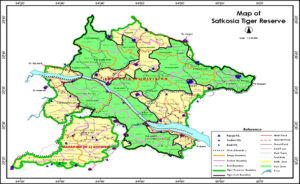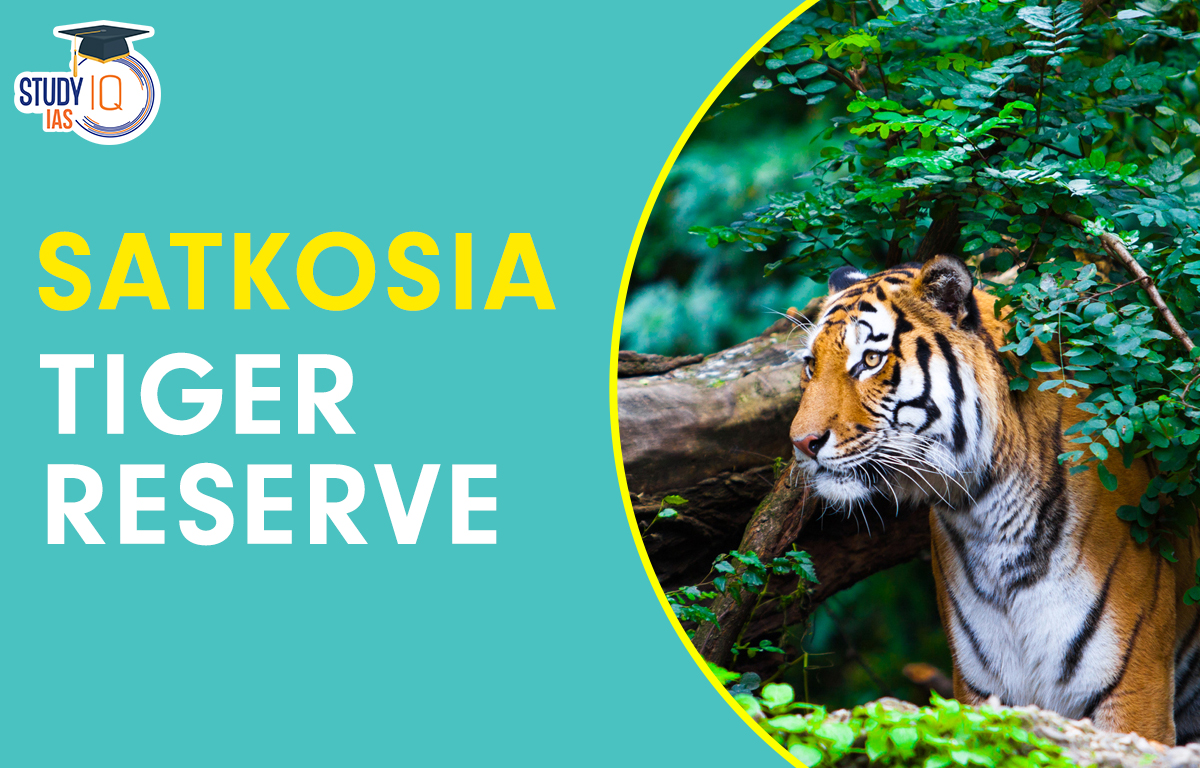Table of Contents
Satkosia Tiger Reserve
Satkosia Tiger Reserve is located in the Indian state of Odisha, in the eastern part of the country. It is situated in the Angul and Nayagarh districts and covers an area of about 964 square kilometers. The reserve is situated on the eastern ghats, which is a mountain range in India.
The history of Satkosia Tiger Reserve dates back to the early 1970s when it was declared a wildlife sanctuary. Later in 2007, it was declared a tiger reserve. The reserve is named after the Satkosia gorge, which is located on the Mahanadi River, and is known for its stunning beauty.
As for the number of tigers in Satkosia Tiger Reserve, according to the latest census conducted in 2018, there are 28 tigers in the reserve. However, this number is subject to change as tiger populations are constantly monitored, and new censuses are conducted periodically to keep track of their numbers. Apart from tigers, the reserve is home to a variety of other wildlife species, including elephants, leopards, deer, and several species of birds.
Read about: Periyar Tiger Reserve
Satkosia Tiger Reserve Landscape
Satkosia Tiger Reserve is located in the eastern part of India and is situated on the eastern ghats, which is a mountain range in India. The reserve is home to several mountains, including the Mahendragiri and the Baisipalli hills. These mountains offer a stunning backdrop to the reserve and add to its natural beauty.
The Mahanadi River flows through the Satkosia Tiger Reserve, and it is the lifeline of the region. The river is a major source of water for the reserve and supports a wide variety of aquatic life, including fish, crocodiles, and turtles. There are several streams that flow through the reserve, including the Kusumi, Baghalati, and Ganiakhola.
One of the main attractions of the Satkosia Tiger Reserve is the Satkosia Gorge, which is a stunning natural feature that is created by the Mahanadi River as it flows through the mountains. The gorge is about 22 kilometres long and is a popular destination for tourists who come to enjoy the breathtaking scenery and take part in activities such as rafting and boating.
Another important relief feature found in the Satkosia Tiger Reserve is the Tikarpada waterfall, which is located on the Mahanadi River. The waterfall is about 15 meters high and is a popular spot for tourists to relax and enjoy the beauty of nature. The reserve is also home to several other waterfalls, including the Badamul and Devi falls.
Read about: Sariska Tiger Reserve
Satkosia Tiger Reserve Map
Here is a map of the Satkosia Tiger Reserve given below for a better understanding:

Satkosia Tiger Reserve Fauna
Satkosia Tiger Reserve is home to a diverse range of fauna, including a variety of mammals, birds, reptiles, and amphibians. The reserve also has a rich population of fish and invertebrates. Here is detailed description about them.
| Fauna Category | Important Species | Interesting Facts |
| Mammals | Bengal Tiger, Indian Elephant, Leopard, Wild Boar, Spotted Deer | The reserve is home to a healthy population of tigers, and efforts are being made to reintroduce cheetahs to the reserve. |
| Birds | Indian Peafowl, Grey Hornbill, Indian Roller, Crested Serpent Eagle, Grey-headed Fishing Eagle | Over 200 species of birds have been recorded in the reserve, making it a popular destination for birdwatchers. |
| Reptiles | Mugger Crocodile, Indian Python, King Cobra, Indian Chameleon, Indian Rock Python | The Mugger Crocodile, a critically endangered species, is found in the rivers and streams of the reserve. |
| Amphibians | Indian Bullfrog, Indian Tree Frog, Common Toad, Indian Green Frog, Golden-backed Frog | The reserve is home to several species of frogs, including the Golden-backed Frog, which is found only in the eastern ghats. |
| Fish | Mahseer, Rohu, Catla, Channa punctatus, Wallago attu | The Mahseer, a popular game fish, is found in the rivers and streams of the reserve. |
| Invertebrates | Indian Swallowtail Butterfly, Indian Skipper, Giant Atlas Moth, Indian Silkworm Moth, Common Bluebottle | The reserve is home to a wide variety of insects and other invertebrates, including several species of butterflies and moths. |
Read about: Valmiki Tiger Reserve
Satkosia Tiger Reserve Flora
The flora of Satkosia Tiger Reserve is characterized by a mix of trees, shrubs, grasses, climbers, and aquatic plants. The vegetation plays a crucial role in providing habitat, food, and shelter for the diverse array of wildlife that calls the reserve home. Following table provides a detailed description.
| Flora Category | Important Species | Interesting Facts |
| Trees | Sal, Teak, Arjun, Indian Rosewood, Bamboo | The Sal tree is the dominant tree species in the reserve and is an important source of timber. |
| Shrubs | Indian gooseberry, Indian barberry, Butterfly pea, Wild Jasmine, Indian Coral Tree | Shrubs and undergrowth in the reserve provide important habitats for small animals and birds. |
| Grasses | Kans grass, Elephant grass, Spear grass, Maidenhair grass, Bermuda grass | Grasslands in the reserve provide important habitats for herbivores such as deer and wild boar. |
| Climbers | Poison Ivy, Indian Creeper, Velvet Bean, Heart-leaved Moonseed, Flame Lily | Climbers are an important part of the reserve’s ecosystem, providing shelter and support for a wide variety of other plant species. |
| Aquatic Plants | Water Hyacinth, Lotus, Water Lily, Duckweed, Water Caltrop | Aquatic plants play an important role in the ecology of the rivers and streams in the reserve, providing food and shelter for fish and other aquatic animals. |
Read about: Parambikulam Tiger Reserve
Satkosia Tiger Reserve Tourism
The best time to visit Satkosia Tiger Reserve is from November to March, when the weather is pleasant and the wildlife is easily spotted. The reserve can be reached by air, rail, and road. The nearest airport is in Bhubaneswar, which is about 160 km away from the reserve. The nearest railway station is at Angul, which is about 70 km away.
Tourists visiting Satkosia Tiger Reserve can expect to go on wildlife safaris, birdwatching tours, and nature walks. The reserve also offers opportunities for camping, boating, and fishing. Visitors can stay in eco-friendly resorts and homestays that offer comfortable accommodation and local cuisine.
Nearby tourist places include the ancient city of Cuttack, which is known for its historic temples and rich cultural heritage, and the temple town of Puri, which is famous for its beaches and Jagannath temple. Another nearby attraction is the Chilika Lake, which is the largest brackish water lagoon in Asia and is home to a variety of bird species.
Read about: Buxa Tiger Reserve
Satkosia Tiger Reserve UPSC
The Satkosia Tiger Reserve is an important topic for the UPSC Syllabus as it falls under the Environment and Ecology section, which is a crucial part of the UPSC Prelims and Mains examination. Aspirants preparing for the UPSC exam can expect questions related to the biodiversity of the region, conservation efforts, and sustainable tourism practices.
Studying about Satkosia Tiger Reserve can be helpful for UPSC aspirants who are enrolled in StudyIQ UPSC Online Coaching as they provide comprehensive courses on the Environment and Ecology section. The online coaching platform offers video lectures, study materials, and UPSC Mock Test that cover the latest updates and trends in the field of environmental science.
Read about: Mudumalai Tiger Reserve


 Goods and Services Tax (GST), Objectives...
Goods and Services Tax (GST), Objectives...
 World Oceans Day 2025, History, Theme, S...
World Oceans Day 2025, History, Theme, S...
 World Environment Day 2025, Theme, Histo...
World Environment Day 2025, Theme, Histo...





















